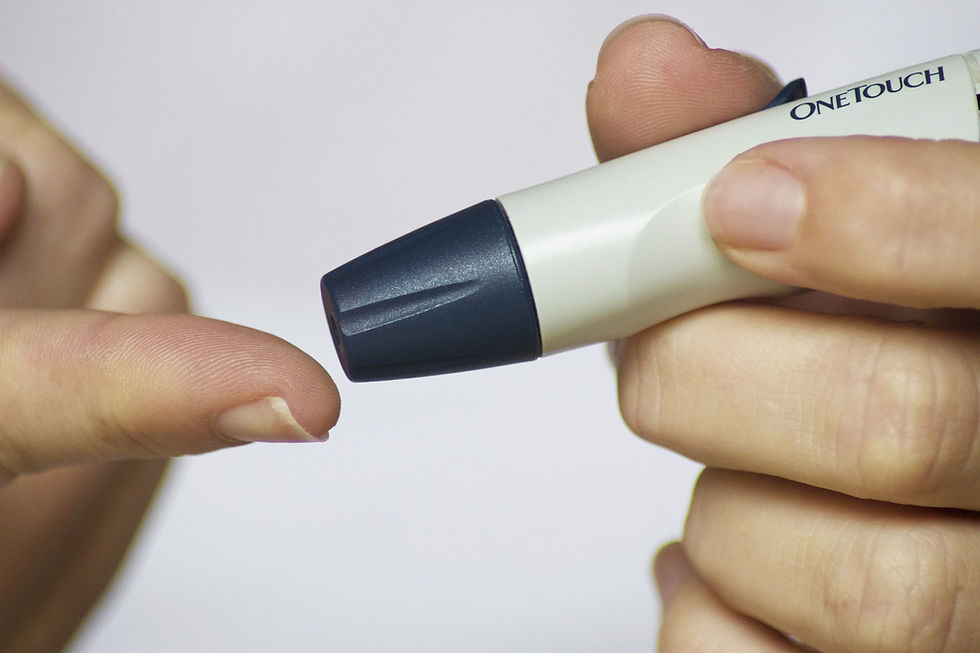Prediabetes Isn’t a Diagnosis — It’s a Wake-Up Call.
- Deepa Bhat
- 17 hours ago
- 2 min read
HbA1c, also known as Glycated Hemoglobin, is a blood test that reflects your average blood sugar (glucose) levels over the past 2 to 3 months.
Here’s what it means in simple terms:
When sugar (glucose) circulates in your blood, some of it attaches to a protein in your red blood cells called hemoglobin. This combination is called HbA1c. Since red blood cells live for about 120 days, measuring the percentage of HbA1c gives a good long-term picture of how much sugar has been in your blood.

Normal and Diabetic Ranges:
Below 5.7% – Normal
5.7% to 6.4% – Prediabetes
6.5% or higher – Diabetes
Why is it important to understand Prediabetes?
It helps diagnose diabetes or prediabetes.
For people already diagnosed, it helps check how well their diabetes is controlled over time.
Unlike regular blood sugar tests, it isn’t affected by what you ate the night before.

If your HbA1c is between 5.7% and 6.4%, you’re in the prediabetes range. This is a critical window — the good news is that with the right changes, you can reverse it and prevent Type 2 diabetes.
Here are 3 key things to do for Prediabetes:
If your HbA1c falls between 5.7% and 6.4%, it means you’re in the prediabetic range. It’s not diabetes yet — but it’s your body signaling that your blood sugar regulation is starting to falter.
The good news? This stage is reversible. With consistent, mindful changes to your lifestyle, you can bring your numbers back to a healthy range and prevent future complications. Here’s where to begin:
1. Rethink Your Plate – Simple Swaps, Big Results
Refined carbs and sugars cause blood sugar spikes. Start by:
Cutting down white rice, white bread, sugary snacks, and packaged foods.
Switching to whole grains like millets, brown rice, and quinoa.
Adding plenty of fiber-rich vegetables and healthy proteins (like eggs, lentils, chicken, or tofu).
Including good fats like nuts, seeds, olive oil, or avocado to slow sugar absorption.
A well-balanced plate stabilizes energy, curbs cravings, and keeps insulin levels in check.

2. Move Your Body – Daily, Not Occasionally
You don’t need intense workouts — just 30–45 minutes of consistent movement daily makes a massive difference.
Walking, yoga, cycling, dancing, or strength training — pick what you enjoy.
Bonus tip: Take a 10-minute walk after meals to reduce post-meal sugar spikes.
Movement improves insulin sensitivity and helps your body use glucose more efficiently.

3. Fix Your Sleep, Fix Your Sugar
Lack of sleep increases cravings and insulin resistance.
Aim for 7–8 hours of restful, deep sleep.
Power down devices at least 30 mins before bed.
Use calming rituals like journaling, meditation, or breathwork to manage stress and sleep better.
Stress hormones like cortisol also raise blood sugar — so managing stress is just as crucial as diet or exercise.

Prediabetes is not the end — it’s your chance to start again.
With small, sustainable steps, you can turn this around and build a healthier, more energetic future.
Need help creating a plan tailored to your body and schedule? Let’s connect.
Comentarios